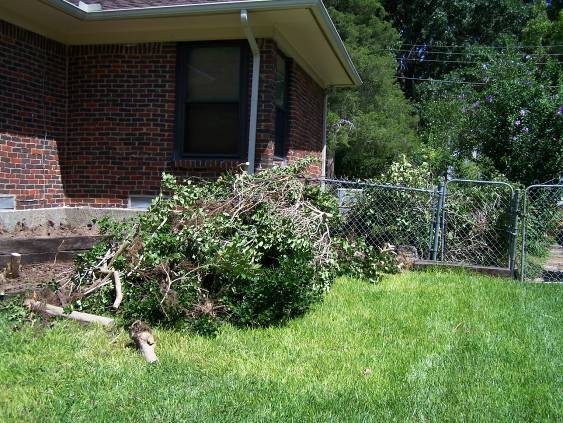Be sure you read part 2 before reading this.
At this point, we are ready to order landscaping materials. We shopped around. I got a good price at Living Earth Technology because I was able to use their wholesale prices due to a connection I had with one of their largest customers. (You may be able to get wholesale prices if you just fill out their wholesaler application. Or if you know me and need materials, talk to me. I may be able to get you a discount.)
We ordered 5 cubic yards of compost, 5 cubic yards of azalea soil, and 3 cubic yards of pine bark mulch.
Two of our very generous friends showed up at 8:30 AM on Saturday, Oct. 1. Shortly afterwards, Living Earth’s truck showed up:
Oh, my gosh, I didn’t expect such a big truck!
That huge thing takes up almost all of my driveway:
Here it is dumping out the materials:
Living Earth dumps each material in the dump container, separating them with thick plastic. The driver raises the dump container just enough to dump out the first load. Then he moves forward a bit, raises it further, and empties out the second load:
You’re seeing the pine bark mulch on the ground. In the bed is the azalea soil, and under that, under plastic sheeting, is the compost.
Now all the azalea soil is on the driveway:
Emptying out the final load, compost:
The aftermath:
Left to right: compost (stinking like poop with flies circling all over it), azalea soil, and pine bark mulch.
I am pretty sure they gave us more of each material than we ordered.
First order of the day was to retill the flower bed by the front sidewalk. It turns out we needed to have gone much deeper than we did. Here the dirt has been shoveled out and is waiting for a retill:
I didn’t take many more pictures of the day’s events, but here’s what we did next. We retilling that bed and then tilled in over 3″ of compost. Then we tilled in about 3″ of compost to the second tier of the rest of the front landscaping, and we filled in the bottom tier (the dished out area) with azalea soil. That took us until about 1:30. Here’s the aftermath:
After that, we had lunch and then went into the back yard. We had to completely retill the “easy” part of the back yard beds to get a deep till. Then we added and later tilled in a generous amount of compost:
The above picture was taken at 6:10 PM. Remember that we had been working since 8:30 AM with few breaks! That was a LONG DAY!
The other side of the back porch was a mess. It had never been tilled right at all, it was full of tree roots, and it has a drainage problem. One of the guys and I spent almost the whole afternoon surgically removing as few roots as we could manage and digging a trench for some 4″ plastic perforated landscaping pipe I am going to use to correct the drainage problem.
Those two guys ended up staying until 8:00 PM. That’s right, almost 12 hours of help in the hot sun. They were beat!
By the way, we had to get rid of the gas lamp. It had rotted out around the base:
It sits waiting to be hauled off:
By the way, some people had hypothesized that the reason this lamp didn’t work right was because of a clogged gas line. Nope, the line was fine:
The next day, Sunday, Oct. 2, Jennifer and I spent the afternoon and early evening finishing out everything. We added more compost to beds and mulched almost everything.
I spent more time on the difficult part of the back yard. Here is what I ended up with:
I got it prepped fairly decently, but I stopped because of the tree roots. I have since checked a few web sites and consulted with a respected landscape architect, and I really don’t have much to worry about as long as I limit my cutting to the 3½ foot width of this bed. The tree is a healthy, mature American elm, and I would only be disturbing a small portion of its entire root system. Because we live in a moderately dry area, this tree’s roots probably go at least 10-15 feet deep. If the tree’s root system could be seen as a pie, I am only affecting one small sliver of the pie.
That tree is in the center of this shot:
So this upcoming weekend, I will probably cut out the remaining roots and deeply till and prep the remainder of that bed.
By the way, I discovered what half the drainage problem was:
The gutter was full of leaves, so water couldn’t even get to the downspout.
Here’s how everything looks right now.
Back yard (the not difficult side):
Nicely mulched and “ready to go” front beds:
More of the same for the front:
One thing I am not sure about is whether this steep of a slope of azalea mix can withstand heavy rains. I may need to add a row of railroad ties across the front.
Our plants come in this weekend! We’re excited!












